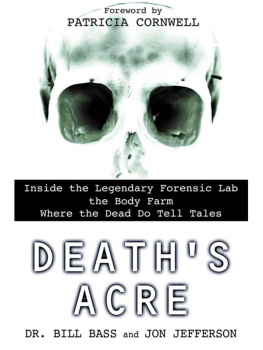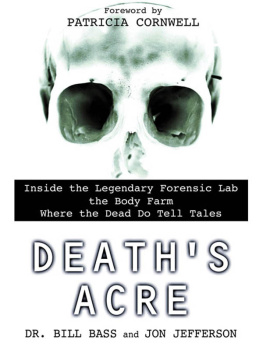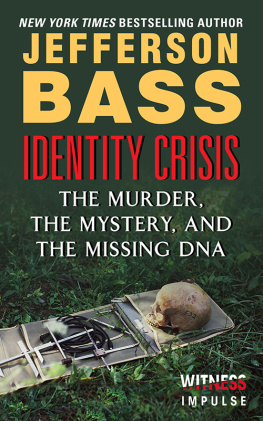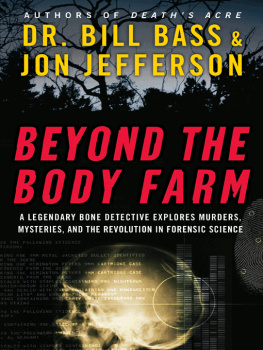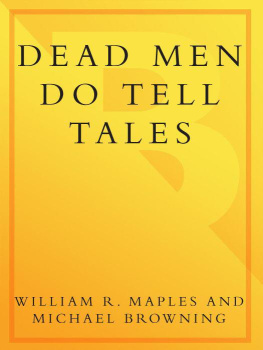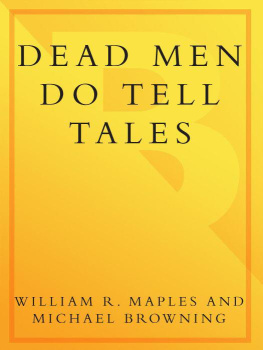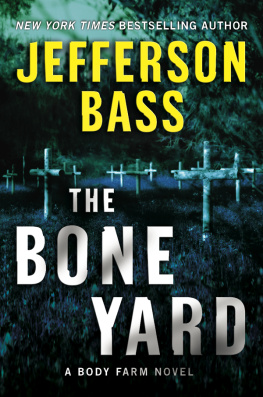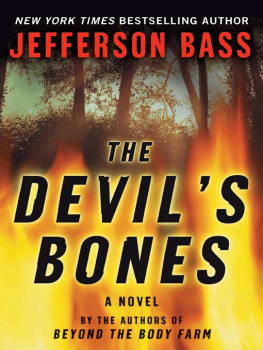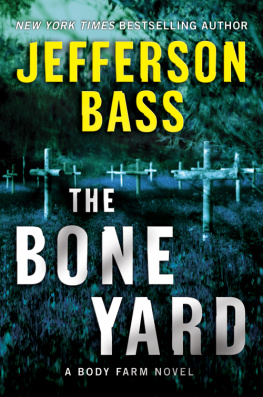G. P. Putnams Sons
Publishers Since 1838
a member of
Penguin Group (USA) Inc.
375 Hudson Street
New York, NY 10014
Copyright 2003 by Dr. Bill Bass and Jon Jefferson
Foreword copyright 2003 by Cornwell Enterprises, Inc.
Unless otherwise indicated, all photos are the copyright of Dr. Bill Bass.
All rights reserved. This book, or parts thereof, may not be reproduced in any form without permission.
Published simultaneously in Canada
Making or distributing electronic copies of this book constitutes copyright infringement and could subject the infringer to criminal and civil liability.
FOREWORD
The Mayor of the Body Farm
M OST PEOPLE who attend national or international forensic science and forensic medical meetings spend more time trying to find which ballroom whatever presentation is in than the presentation itself lasts. Since I have no sense of direction, even inside hotels, I have missed my share of fifteen-minute slide shows and lectures, and arrived far too late for the handouts, too.
Missing breakfast meetings is harder to do. They are located in the dining room you eat in three times a day, and last at least an hour, usually beginning at 7:30 A . M . when everyone is tired, perhaps hungover, but enthusiastic nonetheless about seeing slides of people who were mauled to death by sharks, bears, and alligators, or killed in commercial airline crashes, or perhaps dismembered in unusual ways for unusual reasons, or committed suicide using unexpectedly creative means such as a pneumatic hammer or a crossbow. (In one sad case, when the arrow failed to kill the poor man, he pulled it out of his chest and tried again.)
The experienced and the brave ate their bacon and eggs, undaunted by the sights and sounds of gory horrors, and I was often among them, taking notes and handling myself professionally and without flinching until one rather awful early morning when the legendary Dr. Bill Bass shuffled in with boxes of slides askew under one arm and notes flapping under the other. His breakfast topic was the Body Farm, and despite prevailing rumors that I coined that name for the only human decay research facility of its kind in the world, I didnt. The first time I met the self-effacing, funny, and brilliant Dr. Bass, I had never heard of the Body Farm. Within an hour, and without premeditation, he ruined my taste for undercooked scrambled eggs, fatty bacon, and congealing grits for the rest of my life.
Good God, I said, appalled, early into the first slide presentation of his I had ever seen (in Baltimore, I think). I cant believe hes showing this while were eating!
Dr. Marcella Fierro, the chief medical examiner of Virginia, buttered a roll and ignored me as Dr. Bass slowly clicked through one slide after another, depicting how speedily a body can skeletonize in very hot, humid weather, such as one finds in the South during the summer. I looked around the crowded room at forensic scientists and forensic pathologists, all of them buttering their rolls and stirring their coffee, some taking notes.
My God. I pushed my plate away when Dr. Bass began to focus on maggots. This should never be shown at a breakfast meeting!
Shhhhh! Dr. Fierro nudged me with her elbow.
I avoided all such breakfasts and the Body Farm for many years. Often, scientists urged me to visit Dr. Basss facility in Knoxville, Tennessee.
No, I would say.
You really should. Its not just about decomposing bodies and maggots and all that. Its about how we determine time of death, or whether a body was moved after death and where it might have been before it was moved, and who the dead person was, and how he or she died, and on and on.
Dr. Bass is jokingly referred to as the mayor of the Body Farm. In the early days of my eventual visits, just inside the razor wiretopped wooden fence, was a mailbox that the anthropologists used for leaving each other notes and messages. How odd it seemed the first time I followed that unmistakable stench of decaying human flesh and entered the acre of the dead and was greeted by a mailbox with its red flag at high alert.
Its really not a mailbox for our residents, Dr. Bass told me rather sheepishly, as if it might enter my mind that the dead people scattered about might write home to catch up on the news. Its just we dont have a phone out here.
They still dont. The scientists may carry cell phones, as I do, but most of us dont pull them out while wearing grubby protective gloves and perhaps rubber boots and surgical masks. When youre busy inside the Body Farm, you rarely think of calling anyone for any reason.
Throughout my career, I have emphasized that forensic experts, such as my character Dr. Kay Scarpetta, hear the dead speak. The dead have much to say that only special people with special training and special gifts have the patience to hear, despite the assault on the senses. Only special people can interpret a language very few among the living care about, much less understand.
Welcome to Dr. Bill Basss Body Farm, the one that physically exists right this minute on a wooded patch of death-soaked land behind a hospital in the hills of Tennessee. Many of his silent guests arrive through their own selfless choosing (often making their own reservations months, even years, in advance, donating their bodies to Dr. Basss remarkable ongoing study). Daily, wounded and worn-out bodies melt into the earth and are carried away by birds and insects and other predators who are simply part of the food chain and not the least bit morbid.
Changes to what was once human flesh can be as slight as the shift in a shadow or as dramatic as a conflagration inside one of the old, rusted cars you might find lying around at the Body Farm. Years come and go, as do the dead who have been reduced to ashes and bone, and all of Dr. Basss patient translation adds to the fluency of a secret language that helps condemn the wicked and free those who have done no wrong.
Patricia Cornwell
CHAPTER 1
The Bones of the Eaglet
A DOZEN TINY BONES , nestled in my palm: They were virtually all that remained, except for yellowed clippings, scratchy newsreel footage, and painful memories, from what was called the trial of the century.
That label seems to get thrown around quite a lot, but in this case, maybe it was right. Seven years after the Scopes Monkey Trial and half a century before the O.J. Simpson debacle, America was mesmerized by a criminal investigation and murder trial that made headlines around the world. Now I was to decide whether justice had been done, or an innocent man had been wrongly executed.
The case was the kidnapping and death of a toddler named Charles Lindbergh Jr.known far and wide as the Lindbergh baby.
In 1927, Charles Lindbergh, a former barnstormer and airmail pilot, had flown a small, single-engine plane, the Spirit of St. Louis, across the Atlantic Ocean. He did it alone, with no radio or parachute or sextant, staying awake and on course for thirty-three hours straight. By the time he reached the coast of France, news of his flight had reached Paris, and Parisians by the thousands flocked to the airfield to welcome him. The moment he touched down, 3,600 miles after leaving New York, the world changed, and so did Charles Lindberghs life. His achievement brought him fame, fortune, and a pair of nicknames: Lucky Lindy, which he hated, and the Lone Eagle, which reflected both his solo flight and his solitary nature.
Five years after he flew into the limelight, Lindbergh and his wife, Anne, were living in a secluded New Jersey mansion. They had a twenty-month-old son; his parents named him Charles Jr. but journalists called him the Eaglet. It was the heyday of sensational journalism, and savvy reporters and publishers knew that a Lindbergh storyalmost

